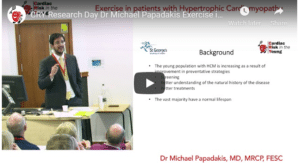Myocarditis is an inflammatory process involving the heart muscle. It can present acutely (suddenly), sub-acutely (of recent onset) or as a chronic disease (weeks or months later). It may present with focal involvement (at a specific location) or diffuse involvement (over a widespread area) of the heart muscle. When individuals have symptoms, these can be highly variable from generalised tiredness, malaise (a general feeling of discomfort), chest pain, breathlessness, electrical abnormalities of the heart and even a cardiac arrest.
Viral infections are the most common cause of myocarditis in the developed world.
How common is viral myocarditis?
The incidence i.e. the number of new cases of myocarditis is approximately 1.5 million worldwide per year and estimated at 10 to 20 cases per 100,000 persons. The exact incidence or prevalence of viral myocarditis is unknown as many cases are subclinical (not severe enough to present definite or readily observable symptoms) and follow a benign course (not serious). According to some estimates, 1-5% of patients with a sudden onset viral infection may involve the heart muscle. So, a small number.
The majority of patients are young and healthy. Individuals who are predisposed include children, pregnant women and those who are immunocompromised (when your immune system’s defences are low).
Does exercise make it more likely you will develop viral myocarditis?
Myocarditis accounts for 5-10% of sudden cardiac deaths (SCD) in athletes and up to 20% of SCD in military recruits, suggesting that exercise may be a trigger for sudden death in this condition.
Clinical data linking intensive physical activity to expressions of myocarditis have not been assessed in humans, but clinical observations do suggest it, given that we do identify a higher prevalence in athletes particularly as they are more likely exposed to germs than the general population. There may be an increased risk of infection with contact sports or team sports with a higher potential for droplet infections.
We know from animal studies, specifically in the Coxsackie virus B3, that there is a reduction in our immune defences induced by intensive exercise that predisposes us to upper lung airway viral infection and possible involvement of the heart muscle.
How many days after a viral illness should you wait before exercising again?
Exercising individuals should be careful when they experience symptoms of coughing, sore throat, running nose or diarrhoea. Viral infection not only affects the heart muscle, but can also cause muscle soreness, joint pains and generalised body fatigue/aches. If an athlete has these symptoms that may or may not be accompanied by a raised temperature, they should refrain from any strenuous exercise as this may further impair the immune system defences and increase the potential for general viral spread and involvement of the heart muscle. Also, with exercise you increase the chances of the virus transitioning from the respiratory/lung-airway system to the circulatory (blood vessels) and may also impair and disrupt the gastro-intestinal tract (digestive tract).
Therefore, athletes with a viral infection should refrain completely from exercise during the acute phase (sudden onset) of the infection. Symptoms to watch for include systemic tiredness (extreme fatigue which doesn’t go away with rest) and increase in body temperature. Once these general symptoms of a cold have completely resolved, one should wait between 3-5 days without symptoms before moderate intensity exercise can be commenced. In severe cases this may extend to 7-10 days.
How long does it normally take to recover from myocarditis?
In acute (sudden onset) severe myocarditis that results in hospital admission, a reduction in the heart function is seen in around 25% and exercise is strongly not recommended during this acute phase. The European Society of Cardiology (ESC) guidelines in sports cardiology recommend that athletes with myocarditis can start regular training, including resistance exercise after complete resolution, after a 3-6 month period. The rest period depends on the severity and development of the disease and may depend on the heart function, electrical abnormalities and the presence of fluid around the heart. 50% of athletes may demonstrate mild forms of myocarditis which does not require hospital admission and resolves within 4-6 weeks. However, strenuous endurance exercise is not recommended for at least 3 months. Exercise training should be gradually increased with rest days in between.
Are there any long-term effects of myocarditis?
Myocarditis begins with the direct invasion (spread) of the infection and its replication either within or near the heart muscle. This results in destruction of the cardiac tissue.
Later, the human immune response/defence system is activated and results in an inflammatory response to the infection.
Acute stage of the disease – direct viral cytotoxicity (quality of being toxic to cells) and focal or diffuse necrosis (death of body tissue/cells) or destruction of the heart muscle.
Subacute – Human immune activation mediated injury creating autoantibodies (an antibody produced by the immune system that is directed against the body’s own proteins) that react to the heart muscle with inflammatory proteins.
Chronis phase – Diffuse heart muscle scarring and reduction of heart function which may lead to a dilated cardiomyopathy (heart muscle condition with reduced contraction). Therefore, the long-term effects include heart failure, dangerous electrical abnormalities and an abnormal baseline electrical trace.
At what point should I seek medical attention if I am developing symptoms similar to myocarditis? What are the symptoms of myocarditis?
Patients typically present within 7-14 days of a flu-like illness that includes fever, generalised body and muscle ache, vomiting, diarrhoea, chest pain worse on breathing in, breathlessness, and palpitations (fluttering in the chest). Your vital signs may be abnormal, including a high temperature, increasing heart rate, and breathing rate and sometimes dizziness from a low blood pressure. If an individual has any of the symptoms described above, they should seek advice from a medical professional.
If you had myocarditis once, are you more susceptible to have it again?
Yes, myocarditis can recur and there is no known way to prevent recurrence of myocarditis. However, the risk of recurrence is low (probably about 10-15%). However, I recommend to my patients that they get a intermittent echocardiogram, especially if they think they are having recurrent symptoms. Your cardiologist will suggest frequency of follow up.
If a family member has had myocarditis, does that make me/my genetics more predisposed to developing myocarditis? Should first degree family members be referred for screening after a young SCD where the cause has been recorded as myocarditis?
Myocarditis is not inherited (i.e, it is not running in the family); it is an acquired condition. There are no known genes associated with human myocarditis. When multiple family members are affected, the cause is usually due to common infection or environmental exposure, but the chances of this occurring are very low.
There are no known genes associated with human myocarditis. However, arrhythmogenic cardiomyopathy (familial heart muscle condition associated with electrical abnormalties, fatty deposits and inflammation) causes a form of myocarditis in the course of the disease process. Therefore, following the post-mortem assessment if there are no other associated features of arrhythmogenic cardiomyopathy (which also includes fatty replacement of heart tissue) and the pathology is purely associated with inflammation process of myocarditis, then first-degree relatives do not need to be referred for further screening evaluation. However, if there is any doubt or family members are feeling anxious, you can always undergo a cardiac screening via charities like Cardiac Risk in the Young and have peace of mind.
Will myocarditis affect my pregnancy?
Myocarditis during pregnancy is rare. Its clinical presentation varies from being completely free of symptoms, having mild generalised symptoms, to serious heart failure and life-threatening electrical abnormalities. Diagnosis is based on a combination of clinical features, the electrical trace, blood tests and imaging that would include echocardiography and cardiac MRI.
How can drug misuse lead to myocarditis?
Athletes may be taking medications, such as tricyclic antidepressants, or drugs such as cocaine which can cause a toxic myocarditis. The precise mechanism remains unclear but does result in an inflammation of the heart muscle. Toxic myocarditis, even if recognised early in its course, may not be reversible. However, withdrawal of the offending drug and continued follow-up is essential for effective management.
I have seen that myocarditis is most commonly caused by Enteroviruses. If I have developed myocarditis from one of the Enteroviruses, how long will I be contagious for after getting the virus and after starting symptoms? Is COVID-19 in the family of Enteroviruses and can it cause Myocarditis?
The contagious period for an enterovirus infection starts 3 days after infection and remains for about 10 days after symptoms develop. Infectious individuals can shed the virus without having symptoms. Enteroviruses are members of the picornavirus family and include Coxsackie A, Coxsackie B virus and Echovirus. SARS – Coronavirus – 2 disease (COVID-19) is an infectious disease caused by a newly discovered family of viruses known as coronaviruses. Other coronaviruses are capable of causing illnesses ranging from the common cold to more severe diseases such as Middle East respiratory syndrome (MERS). COVID-19 can cause myocarditis and the prevalence is around 7%.
How can systemic lupus erythematosus and other autoimmune diseases cause Myocarditis? I have an autoimmune disease, should I be worried? What can I look out for?
The disease most strongly associated with the development of myocarditis is systemic lupus erythematosus, but it might also occur in association with Sjogren’s syndrome, vasculitis and Polymyositis. These conditions can cause inflammation of the body as well as the heart muscle through mounting an autoimmune response. Additionally, because these autoimmune conditions create an added risk for developing infection especially if you are taking immunosuppressive drugs places you at increased risk for developing infectious myocarditis.
If you have an autoimmune condition, you should seek advice from your rheumatologist, especially if you are taking medications that may potentially suppress your immune system.




